Villagers in Linqing (临清), Shandong Province (山动省) dig for old coins in China’s ancient Grand Canal (大运河) when the water level is low, according to an article published July 2, 2015 by linqing zaixian (临清在线).
The Grand Canal is the longest canal in the world. Construction began in the 5th century BC. The canal runs from Beijing (北京) to Hangzhou (杭州) and links the Yellow River (Huang He 黄河) and the Yangtze River (Chang Jiang 长江).
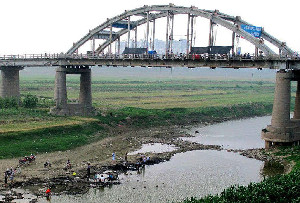
The Grand Canal beneath the Linqing Bridge. Villagers can be seen digging for coins at the lower left.
Linqing is located about 380 km (240 mi) south of Beijing where the Wei River (卫河) meets the Grand Canal.
During the Ming (明朝 1368-1644) and Qing (清朝 1644-1912) dynasties, Linqing was an important trading center for textiles and grains. It was also famous for its brickyards which produced bricks that were used to build palaces and tombs in the capital.
Linqing’s nightlife was immortalized in the famous Ming dynasty sexually graphic novel Jin Ping Mei (金瓶梅), known in the West as The Plum in the Golden Vase or The Golden Lotus:
《金瓶梅》书中所写临清是个热闹大码头去处,“有三十二条花柳巷,七十二座管弦楼”.
Linqing is a place having large and bustling docks with “thirty-two ‘Flower and Willow’ lanes and seventy-two ‘Wind and String’ houses”.
“Flower and Willow” refers to a red-light district (花街柳巷) and “Wind and String” (musical instruments) refers to sing song houses.

Villagers digging for buried coins
The months of June and July are traditionally the dry period along the Wei River. Whenever the water level is low, the villagers take the opportunity to dig for ancient coins on the river bottom.
At the left, villagers can be seen digging for the buried “treasure”. The villager in the red shirt can even be spotted in the image of the bridge above.
The coins recovered are usually from the Ming or Qing dynasties but much older coins are also found.

Qing Dynasty coins dug up in Grand Canal
Shown at the left are the Qing dynasty coins a villager found after only a few minutes of digging.
Even though the coins have been buried for hundreds of years and show surface corrosion, the coin inscriptions can still be easily read.
The inscription on the coin at the top is qian long tong bao (乾隆通宝) which means the coin was cast during the years 1736-1795 of the reign of the Qianlong Emperor (乾隆帝).
The photograph above shows the Grand Canal as it existed in Suzhou (苏州) during the Qing dynasty.
When conditions permitted, the boats relied on wind power to move along the canal.
Otherwise, the boats were pulled on ropes by teams of men known as “boat trackers” (纤夫), as can be seen in this Qing dynasty photograph.
Since there usually was no tow-path on the shore, trackers frequently waded through chest deep water in the canal.
The boats and barges had flat bottoms. In bad weather conditions, winds could cause them to overturn and lose their cargoes.
After having been buried for several centuries, some of those cargoes have been recovered and are displayed in the the China Great Canal Museum (中国京杭大运河博物馆) located in Hangzhou (杭州).
Among the coins on display are wu zhu (隋五珠) coins dating from the time of the Sui dynasty (隋朝 581-618) when the various sections of the canal were finally combined.
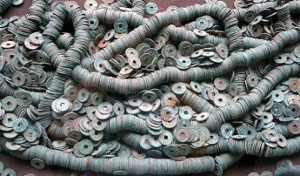
Some of more than 40,000 Tang dynasty “kai yuan tong bao” coins excavated from the Grand Canal in 2004
At the left is a small portion of the more than 40,000 Tang dynasty (唐朝 618-907) kai yuan tong bao (开元通宝) coins that are on display at the museum.
These coins were unearthed in 2004 from the Grand Canal in an area near the Da Guan Bridge (大关桥) in Hangzhou.
A more detailed view of some of the coins is shown here.
As can be seen, the coins are very well preserved despite having been buried for more than 1,300 years.
Large quantities of ancient coins from other dynasties have also been recovered.
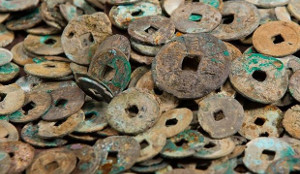
Song dynasty coins recovered from the Grand Canal on display at the Zhongce Accounting Museum in Hangzhou
At the left are some of the Song dynasty (宋朝 960-1279) coins that have been unearthed from the canal.
These coins are on display at the Zhongce Accounting Museum (中策财会博物馆) in Hangzhou.
Like the Great Wall (万里长城), the Grand Canal was one of the monumental engineering projects of ancient China, and to this day continues to reveal its history through discoveries of long buried treasures.

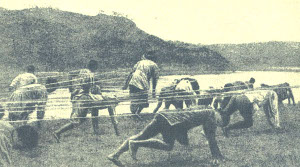
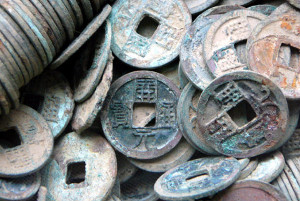
Hi,
Very very informative website. But for me as a beginner its still very difficult.
Would it be possible to get some assistance in identifying some coins i have.
Could send or post pictures somewhere and then maybe try to figure out what they are actually.
Regards and best wishes
Mouthaan R
Holland